The Architectural Association School of Architecture in London has just opened a fascinating exhibition titled Beyond Entropy, When Energy becomes Form. The works on show are part of a two-year project that brings together leading scientists, architects and artists to broaden the ways we think about energy.
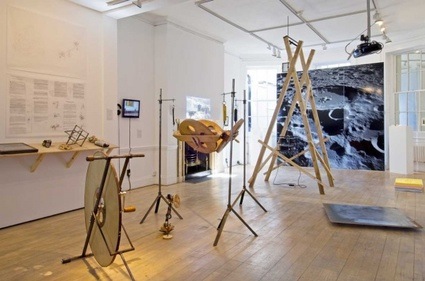 View of the exhibition space. Credit: © Valerie Bennett, The Architectural Association School
View of the exhibition space. Credit: © Valerie Bennett, The Architectural Association School
A wooden time machine, a swinging pendulum that controls the destruction and reconstruction of a building, a highly frustrating pinball machine, forensic photography that captures your movements before the picture is taken, etc. Each work in the room looked at a different type of energy –electric, mechanical, potential, mass, sound, thermal, chemical, and gravitational– in a way that makes us realize how little we know about energy.
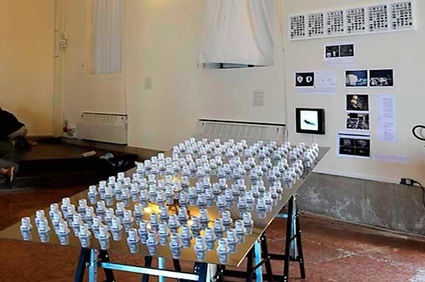 The Thermal Energy prototype. Credit: © Valerie Bennett, The Architectural Association School
The Thermal Energy prototype. Credit: © Valerie Bennett, The Architectural Association School
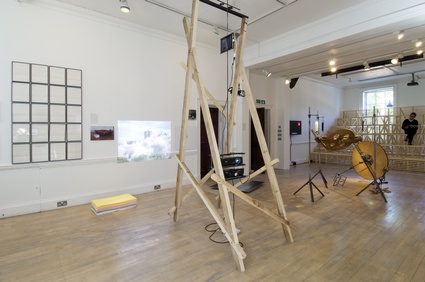 Mass. Credit: © Valerie Bennett, The Architectural Association School.
Mass. Credit: © Valerie Bennett, The Architectural Association School.
MASS intends to break the second law of thermodynamics which wants that entropy always increases, even though the fundamental laws of nature are always symmetrical. A building that collapses never brings itself back together. However, architect Rubens Azevedo, artist Ariel Schlesinger and physicist Vid Stojevic created a system where the film of a building being imploded almost immediately comes back together as a pendulum swings. A pair of film projectors are placed on a pendulum, projecting the image of the building. The image remains motionless as long as the pendulum doesn’t move. A swinging pendulum is a symmetrical, non-chaotic system but the projection it governs is chaotic. As the pendulum swings in one direction, the building collapses. When the pendulum swings back, the building comes back together. It goes on and on as long as the pendulum swings.
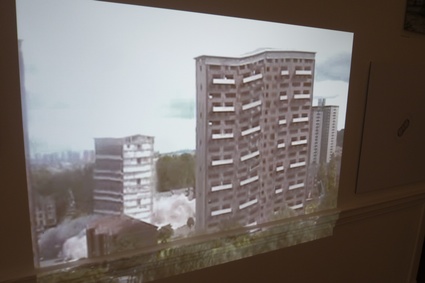
An event which is asymmetrical in time due to the second law of thermodynamics (such as the demolition of a building) is thus made symmetrical by the non-chaotic system (the pendulum.) This moment of entropy is continuously projected on the screen. The prototype currently shown at AA is the first step of a larger-scale installation in which a Foucault pendulum will screen a movie whose speed, in time and space, depends on the rotation of the planet.
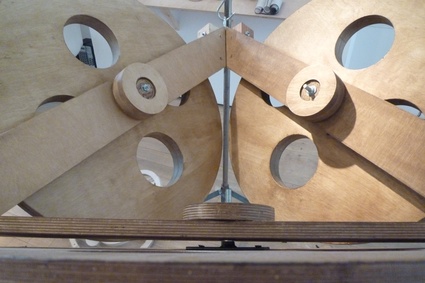 Time Machine (detail)
Time Machine (detail)
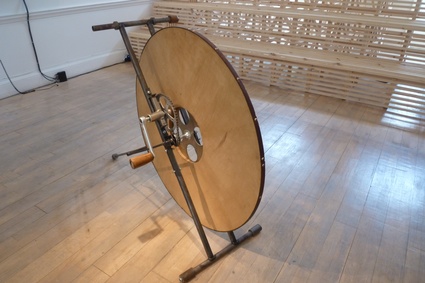 Time Machine (detail)
Time Machine (detail)
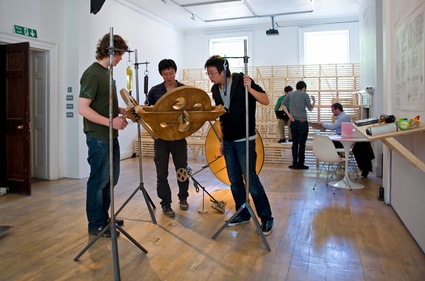 The Time Machine. Credit: © Valerie Bennett, The Architectural Association School
The Time Machine. Credit: © Valerie Bennett, The Architectural Association School
Cosmologist Andrew Jaffe and architect Shin Egashira explored mechanical energy through a whimsical time machine inspired by Alfred Jarry’s Pataphysics, a pseudo-science that investigates what lies beyond the realm of metaphysics. Jarry defined ‘pataphysics as “the science of imaginary solutions, which symbolically attributes the properties of objects, described by their virtuality, to their lineaments.” Jarry theorised a time machine made of giant mechanical flywheels and gyroscopic action to transport the user through time and space. The work on show at AA right now is one element of the prototype to be complete next year. This 21st century’s version of Jarry’s machine uses electric motors, computer-cut plywood, ball-bearings, bicycle parts and digital cameras. In Jarry’s pataphysics, these elements work together to spin at such speed as to resist all forces, eventually even resisting our motion through not just space but time itself. The team has updated Jarry’s machine and hope to achieve the same result the French pataphysician was postulating.
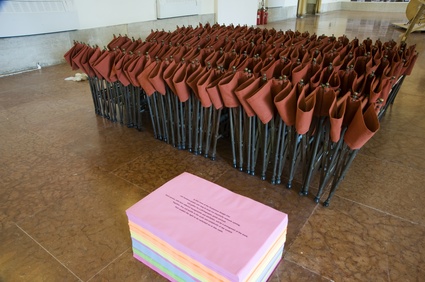
Bankuh, scientist Giuseppe Celardo and artist Alberto Garutti’s way of exploring electric energy is as fascinating as it is simple. It stems from the idea that energy cannot be stored but has to be produced moment by moment. The logic and management that governs the network of the fluxes of energy is influenced by economic and geopolitical factors. The workshop that opened the Beyond Entropy project took place in Fondazione Cini in Venice. The energy arrives there from a dense network of energy-exchange via Sacca Fisola where it arrives from the regions of Veneto, Fruili Venezia Giulia and Emilia Romagna, from gas thermal power stations located in a number of small Italian towns. All of these stations are linked through a network of gas pipes to the sources in Algeria, Russia, Libya, The Netherlands and Norway.
Meanwhile the local coal-fired power plants are supplied with coal from the mines of South Africa, Indonesia, Colombia, Russia, Venezuela and China. The power plants use fuel from Italians localities and draw on feeder pipelines from Russia, Libya, Saudi Arabia, Iran and Iraq. Finally, the hydroelectric stations are in Samplago, Cavilla and Barga while wind turbines are spread around the Southern regions of Puglia and Sicily.
The project hopes to bring together into a room 100 people who have the technical responsibility for managing this complex system behind the electric network. The 100 empty folding chairs await their arrival next year.
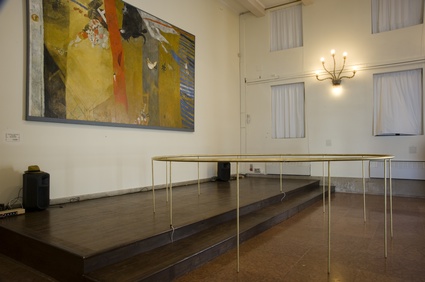 Sound. Credit: © Valerie Bennett, The Architectural Association School
Sound. Credit: © Valerie Bennett, The Architectural Association School
Artist Massimo Bartolini, architects Dario Benedetti, Riccardo Rossi and Salottobuono teamed up to explore the sound our bodies make through their own electromagnetic fields. The brass ring is a giant antenna, picking up electric signals and turning these into sound through speakers. As people approach the antenna, so our electric fields alter the sounds being created.
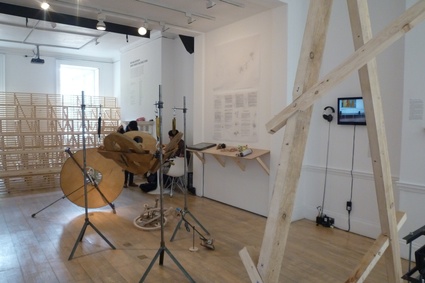
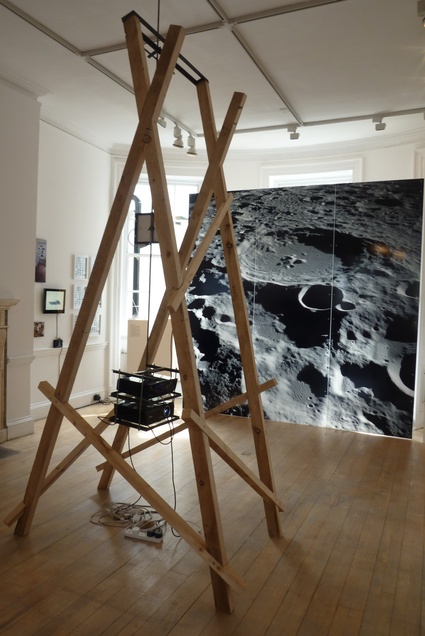 Beyond Entropy is on view at the AA Gallery until 28, May, 2011.
Beyond Entropy is on view at the AA Gallery until 28, May, 2011.
